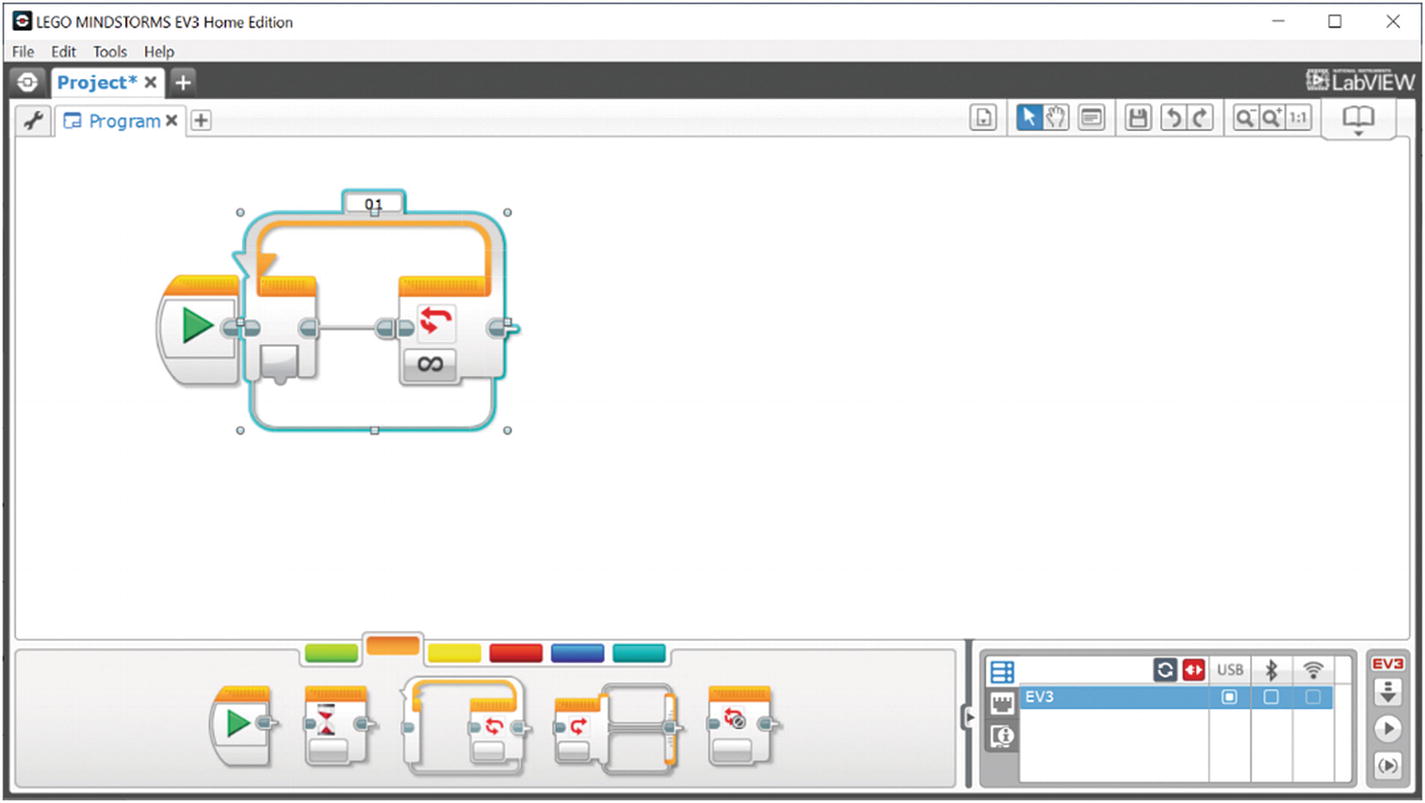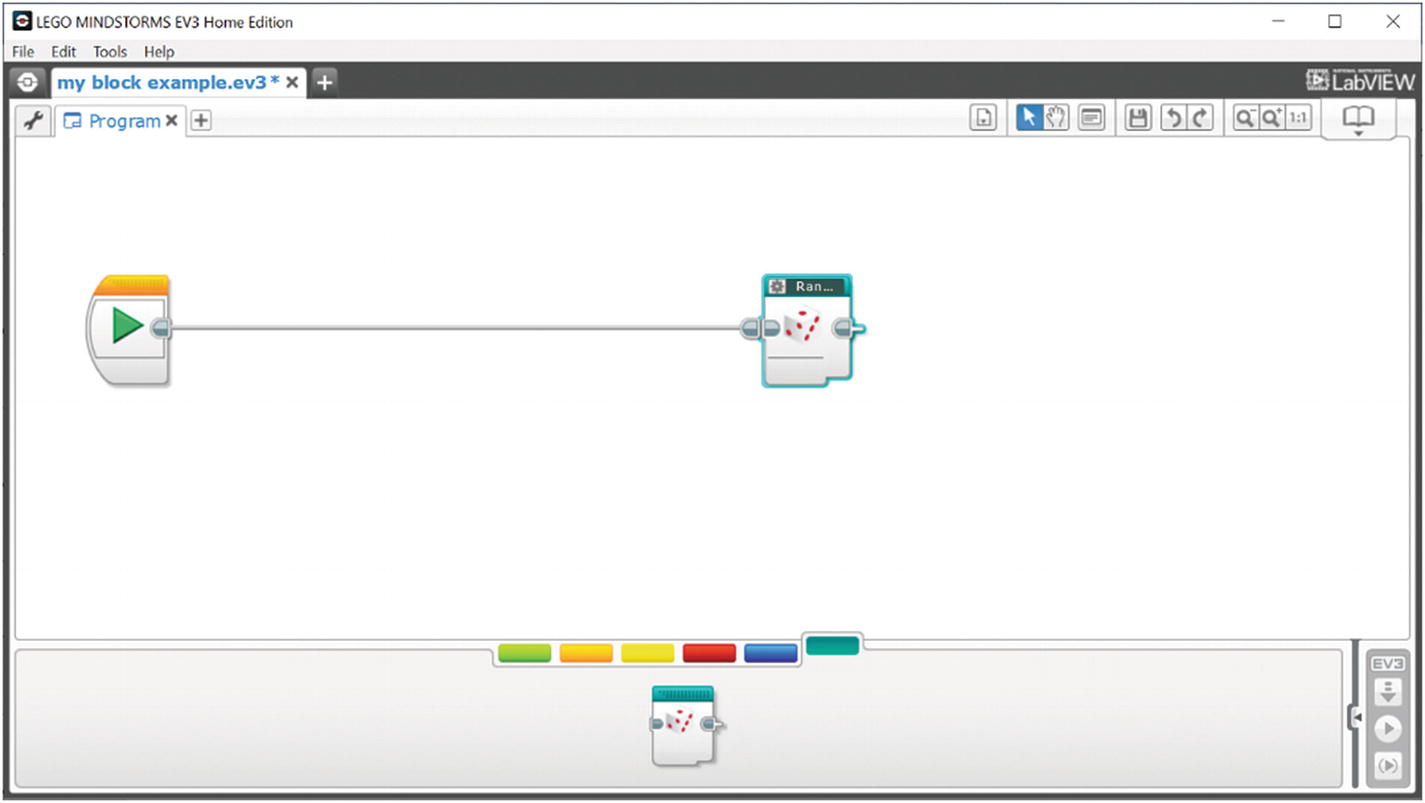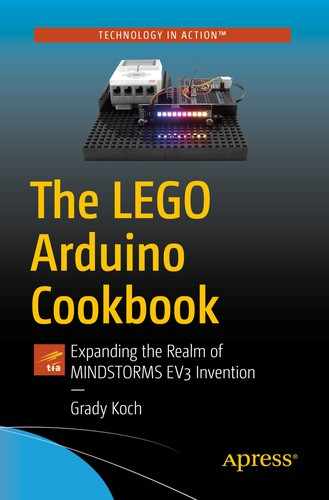A quick overview of the essential steps is presented in this chapter for programming in the MINDSTORMS EV3 environment. After this overview, some of the more advanced programming techniques will be presented that are used in this book including My Blocks and working with third-party developed programming blocks. While there are many programming languages that have been adapted to work with MINDSTORMS, the programming for the EV3 Intelligent Brick used in this book stays with the simple graphical-based environment supplied by LEGO.
Getting Started with the MINDSTORMS EV3 Programming Environment

The welcome lobby screen of the MINDSTORMS EV3 program has options for basic tutorials, as well as creating custom programs

Programs are built in the MINDSTORMS EV3 programming environment by dragging various blocks onto the center section of the screen

Connection to the EV3 Intelligent Brick is confirmed in the lower right-hand corner of the programming environment
Programming

Programming blocks are organized by function under tabs at the bottom of the screen
EV3 code diagrams are part of the project chapters that follow in this book and can be duplicated by pulling in the matching blocks and selecting the options on each block. Or the programs can be downloaded from www.github.com to be imported into the EV3 programming environment. Once the program has been written, it gets downloaded for execution to the EV3 Intelligent Brick by one of the three buttons at the bottom right of the screen: “Download,” “Download and Run,” or “Run Selected.” “Download” places the program into the memory of the EV3 Intelligent Brick, but does not run the program. To run the program, the center button on the EV3 Intelligent Brick is pressed. This download-only option is useful for a situation in which some action of the program, like activation of a motor, needs to be watched closely for proper operation. If no problems are anticipated, then “Download and Run” can be selected as a shortcut to both place the program into memory and run the program. The last option of “Run Selected” is a tool for debugging in which only the code blocks highlighted by mouse selection are run.
Extra and Aftermarket Device Blocks
LEGO makes several sensors that are not included with the EV3 31313 set but that can be purchased separately, including the Energy Meter, Gyro Sensor, Sound Sensor, Temperature Sensor, and Ultrasonic Sensor. The blocks for these sensors have to be downloaded (www.lego.com/en-us/themes/mindstorms/downloads) and installed into the EV3 programming environment. Similarly, aftermarket sensor developers sell devices that will work with MINDSTORMS, including Mindsensors.com, Dexter Industries (www.dexterindustries.com), and Vernier (www.vernier.com). The websites associated with these extra sensors have a downloadable file that can be imported into the EV3 programming environment, where they will appear as programming blocks that can be pulled into use. For example, Figure 2-4 has two programming blocks under the Action tab that are extra devices for a Dexter Industries dSwitch and a Mindsensors LED Matrix. The installation of these programming blocks is done from the toolbar by selecting Tools ➤ Block Import. A prompt will then appear to find the .ev3 file from where it was stored after download from the sensor developer’s website.
My Blocks

Blocks to include in a My Block are first highlighted

Opening the My Block Builder provides areas for user input for name, description, and icon

The new My Block can be pulled into action by selecting it from the My Blocks tab
Summary
This chapter reviewed the setup for the software programming of the EV3 Intelligent Brick. The EV3 Intelligent Brick is programmed by a graphical user interface, assembling various control blocks to create programs. A more advanced use of the EV3 programming environment was introduced with the means to import control blocks that are not part of the core EV3 programming environment. Importing control blocks is associated with both LEGO and aftermarket devices, such as will be found in later chapters of this book. Another advanced feature explored was the creation of My Blocks, user-made subroutines useful for when a set of program blocks will be used repeatedly.
